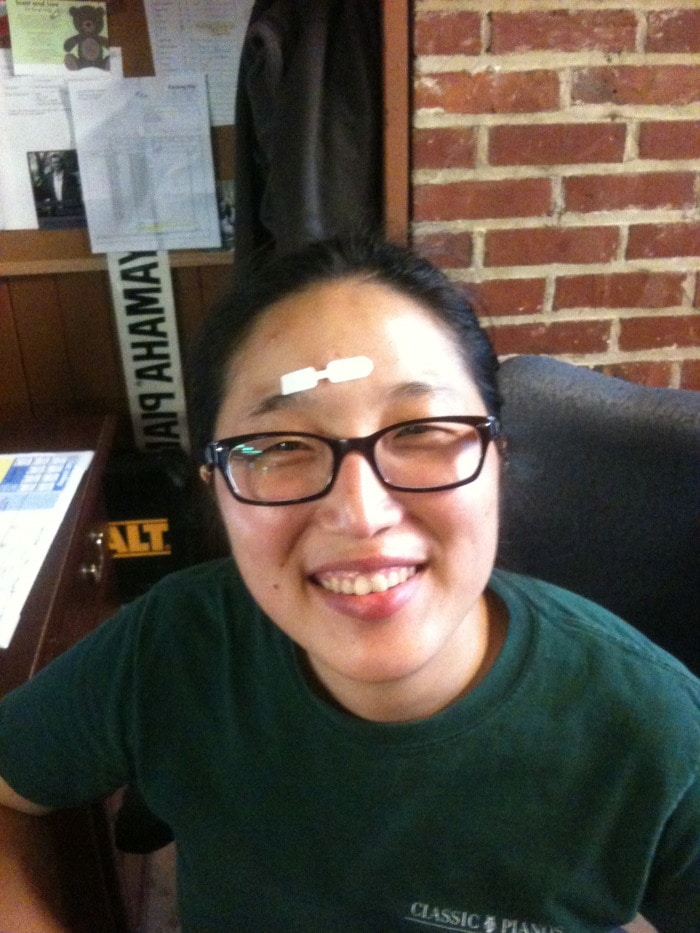Note: Piano Adventures is a regular feature highlighting the quirky aspects of my daily life as a piano technician, from the paradoxical challenges of working with inanimate objects to the characters I meet.
A couple of weeks ago, I was tasked with teaching someone how to replace a broken piano string.

Piano wire is quite stretchy, a fact a lot of people are not aware of because most people never have a reason to experiment with stretching steel. When a piano is at its designated tension, a piano wire is generally at 60% of its tensile strength. So, theoretically, if a piano is well-maintained at the proper pitch, a string should never reach the 100% point at which it will break. However, “should not break” and “will not break” are not the same thing.
So, there are times when every piano technician needs to replace a string. Therefore, there are also times when a piano technician needs to teach apprenticing technicians how to replace a string so as to continue the cycle of responsible piano technicians who can competently replace wire rather than breeding a generation of technicians who surreptitiously close piano lids when a string breaks and assume hope no one will ever notice.
With that in mind, when one of the apprentice technicians at the store where I work noticed a broken string in the Baldwin Acrosonic spinet he was tuning, I decided there was no time like the present to get him more experienced in replacing strings. I gathered up the necessary tools: the correct size of music wire, round-nose pliers, parallel jaw pliers, a tuning hammer, a string spacer, and a few others that I actually don’t know the proper names for but I know I need them when I replace strings. In my mind, they are called “spinning crank thing,” “wooden block dummy-pin thingamajigger,” and so on. What I forgot to grab entirely was a pair of safety goggles.
Okay, actually, I didn’t forget; I have actually developed a bad habit of not using them when I replace strings even though I was taught that they were a necessary item for my safety.
I should have listened.
During the process of replacing this particular string, I was attempting to demonstrate how to thread the wire through the hole of the tuning pin, which is fairly similar to threading a needle. Except while thread tends to be disagreeable by limply flopping around and fraying, piano wire, especially thick piano wire, tends to be disagreeable by being stiff and resistant to going in a particular direction — namely, the direction you want — especially in tight spaces. Since in those tight spaces even my little fingers refuse to fit, pliers, ideally pliers that will not mar the string in any way, are used to hold the wire. (For any of you piano technicians wondering why I did not use the “dummy-pin method,” it was simply not feasible in this situation.)
While gripping the string with a pair of small round-nose pliers (not known for having any sharp edges whatsoever, which is why I was using them), I navigated the wire under what is known as the pressure bar (a metal bar that is the upper termination point of the speaking length of the string in the tenor and treble sections of most upright pianos,) and wriggled it between the other tuning pins until it was just under the correct one.
Here is where I ran into trouble.
At this point, the position of the tuning pin hole was such that the wire needed to be pulled back, a direction in which it really, REALLY did not want to go, in order to be inserted into the tuning pin. In the process of leaning over to get a closer look while pulling back on the string and trying ever so hard to get the end of the string to line up with the tuning pin hole, the pliers I was using violently slipped off the wire and whacked me directly in the forehead.
Or so I thought.
Turns out the the tip of the supposedly not sharp round nose pliers managed to slice over an inch of my forehead open. When I pulled my hand back after reflexively touching it to the spot where the pliers had made contact, it was covered with blood. And more blood was dripping. On the floor. In front of customers.
Not. Good.
My panicked trainee grabbed the first rag he could find, and it quickly began filling up with more blood. I ran upstairs in search of a first-aid kit where I luckily ran into a fellow co-worker who allowed me to sit and put pressure on my head while he went on the hunt for antiseptic. (Have you ever had to run up a flight of stairs with a bloody rag over your eyes while tilting your head back in an attempt to stem the flow of blood? It’s not very much fun.)
Fortunately, our first aid-kit was well equipped with butterfly stitches (though low on antiseptic, which required me to use hand sanitizer in order to disinfect my cut,) which a fellow technician applied — carefully lining up the cut so it wouldn’t heal crookedly, of course — to finally stop the bleeding. That, combined with already having had a tetanus shot earlier in the year, saved me a trip to the hospital.
With that, I was able to continue on with my day and finish assisting my fellow technician with replacing the string (he managed to get the string threaded in my absence), albeit with a bit of a swollen forehead.
A friend later reminded me that I was lucky not to have stabbed out my eye, which made the inevitable facial scar seem not so bad. And, as my husband kindly pointed out, the remnant of the cut is barely noticeable, having healed in 2D rather than the 3D it was when it first happened.
